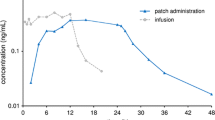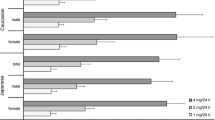Abstract
Rotigotine transdermal patch (Leganto®, Neupro®) is indicated for the treatment of restless legs syndrome (RLS); this article reviews the pharmacological properties of rotigotine transdermal patch and its clinical efficacy and tolerability in patients with RLS. The transdermal patch allows for a continuous, stable release of rotigotine (avoiding first-pass metabolism), which in turn leads to continuous receptor stimulation, believed to closely mimic physiological striatal dopamine receptor function. In short-term and 6-month studies, especially at the higher dosages of 2 and 3 mg/24 h, rotigotine transdermal patch was generally associated with a significantly greater improvement in IRLS total score and CGI-S total score than placebo, and rotigotine recipients were generally more likely to respond to treatment and enter remission. In noncomparative extension studies, efficacy was sustained for ≤5 years. Rotigotine transdermal patch is generally well tolerated, and appears to have a tolerability profile that is similar to that of other non-ergolinic dopamine-receptor agonists. The most common adverse events in clinical trials included application-site reactions, nausea, headache and asthenic conditions. The drug has a relatively low risk of clinically significant augmentation of restless legs syndrome symptoms. In conclusion, rotigotine transdermal patch offers continuous administration of the drug in a daily treatment, and is a useful treatment option in patients with RLS.

Similar content being viewed by others
References
Bogan RK. From bench to bedside: an overview of rotigotine for the treatment of restless legs syndrome. Clin Ther. 2014;36(3):436–55.
Nagandla K, De S. Restless legs syndrome: pathophysiology and modern management. Postgrad Med J. 1053;2013(89):402–10.
Trenkwalder C, Winkelmann J, Inoue Y, et al. Restless legs syndrome-current therapies and management of augmentation. Nat Rev Neurol. 2015;11(8):434–45.
Garcia-Borreguero D, Ferini-Strambi L, Kohnen R, et al. European guidelines on management of restless legs syndrome: report of a joint task force by the European Federation of Neurological Societies, the European Neurological Society and the European Sleep Research Society. Eur J Neurol. 2012;19(11):1385–96.
European Medicines Agency. Leganto® (rotigotine transdermal patch): EU summary of product characteristics. 2011. http://www.ema.europa.eu/. Accessed 14 Mar 2016.
Waters C. The development of the rotigotine transdermal patch: a historical perspective. Neurol Clin. 2013;31(3 Suppl):S37–50.
Scheller D, Ullmer C, Berkels R, et al. The in vitro receptor profile of rotigotine: a new agent for the treatment of Parkinson’s disease. Naunyn Schmiedebergs Arch Pharmacol. 2009;379(1):73–86.
Sanford M, Scott LJ. Rotigotine transdermal patch: a review of its use in the treatment of Parkinson’s disease. CNS Drugs. 2011;25(8):699–719.
Baldwin CM, Keating GM. Rotigotine transdermal patch: in restless legs syndrome. CNS Drugs. 2008;22(10):797–806.
Kehr J, Hu XJ, Goiny M, et al. Continuous delivery of rotigotine decreases extracellular dopamine suggesting continuous receptor stimulation. J Neural Transm. 2007;114(8):1027–31.
Schmidt WJ, Lebsanft H, Heindl M, et al. Continuous versus pulsatile administration of rotigotine in 6-OHDA-lesioned rats: contralateral rotations and abnormal involuntary movements. J Neural Transm. 2008;115(10):1385–92.
Stockwell KA, Scheller D, Rose S, et al. Continuous administration of rotigotine to MPTP-treated common marmosets enhances anti-parkinsonian activity and reduces dyskinesia induction. Exp Neurol. 2009;219(2):533–42.
Stockwell KA, Scheller DK, Smith LA, et al. Continuous rotigotine administration reduces dyskinesia resulting from pulsatile treatment with rotigotine or L-DOPA in MPTP-treated common marmosets. Exp Neurol. 2010;221(1):79–85.
Bauer A, Cassel W, Benes H, et al. Rotigotine’s effect on PLM-associated blood pressure elevations in restless legs syndrome. Neurology. 2016;86(19):1785–93.
Kim BH, Yu KS, Jang IJ, et al. Pharmacokinetic properties and tolerability of rotigotine transdermal patch after repeated-dose application in healthy korean volunteers. Clin Ther. 2015;37(4):902–12.
Cawello W, Kim SR, Braun M, et al. Pharmacokinetics, safety, and tolerability of rotigotine transdermal system in healthy Japanese and Caucasian subjects following multiple-dose administration. Eur J Drug Metab Pharmacokinet. 2015. doi:10.1007/s13318-015-0273-6.
Elshoff JP, Braun M, Andreas JO, et al. Steady-state plasma concentration profile of transdermal rotigotine: an integrated analysis of three, open-label, randomized, phase I multiple dose studies. Clin Ther. 2012;34(4):966–78.
Cawello W, Kim SR, Braun M, et al. Pharmacokinetics, safety and tolerability of rotigotine transdermal patch in healthy Japanese and Caucasian subjects. Clin Drug Investig. 2014;34(2):95–105.
Cawello W, Braun M, Boekens H. Absorption, disposition, metabolic fate, and elimination of the dopamine agonist rotigotine in man: administration by intravenous infusion or transdermal delivery. Drug Metab Dispos. 2009;37(10):2055–60.
Cawello W, Ahrweiler S, Sulowicz W, et al. Single dose pharmacokinetics of the transdermal rotigotine patch in patients with impaired renal function. Br J Clin Pharmacol. 2012;73(1):46–54.
Braun M, Cawello W, Andreas JO, et al. Lack of pharmacokinetic interactions between transdermal rotigotine and oral levodopa/carbidopa. J Clin Pharmacol. 2009;49(9):1047–55.
Braun M, Cawello W, Boekens H, et al. Influence of domperidone on pharmacokinetics, safety and tolerability of the dopamine agonist rotigotine. Br J Clin Pharmacol. 2009;67(2):209–15.
Stiasny-Kolster K, Kohnen R, Schollmayer E, et al. Patch application of the dopamine agonist rotigotine to patients with moderate to advanced stages of restless legs syndrome: a double-blind, placebo-controlled pilot study. Mov Disord. 2004;19:1432–8.
Oertel WH, Benes H, Garcia-Borreguero D, et al. Efficacy of rotigotine transdermal system in severe restless legs syndrome: a randomized, double-blind, placebo-controlled, six-week dose-finding trial in Europe. Sleep Med. 2008;9(3):228–39.
Otsuka Pharmaceutical Co. Ltd. A placebo-controlled study for SPM 962 in restless legs syndrome (RLS) patients (NCT00666965). 2014. http://www.clinicaltrials.gov. Accessed 14 Mar 2016.
Garcia-Borreguero D, Allen R, Hudson J, et al. Effects of rotigotine on daytime symptoms in patients with primary restless legs syndrome: a randomized, placebo-controlled study. Curr Med Res Opin. 2016;32(1):77–85.
Inoue Y, Shimizu T, Hirata K, et al. Efficacy and safety of rotigotine in Japanese patients with restless legs syndrome: a phase 3, multicenter, randomized, placebo-controlled, double-blind, parallel-group study. Sleep Med. 2013;14(11):1085–91.
Hening WA, Allen RP, Ondo WG, et al. Rotigotine improves restless legs syndrome: a 6-month randomized, double-blind, placebo-controlled trial in the United States. Mov Disord. 2010;25(11):1675–83.
Trenkwalder C, Benes H, Poewe W, et al. Efficacy of rotigotine for treatment of moderate-to-severe restless legs syndrome: a randomised, double-blind, placebo-controlled trial. Lancet Neurol. 2008;7(7):595–604.
Oertel WH, Benes H, Garcia-Borreguero D, et al. Rotigotine transdermal patch in moderate to severe idiopathic restless legs syndrome: a randomized, placebo-controlled polysomnographic study. Sleep Med. 2010;11(9):848–56.
Dauvilliers Y, Benes H, Partinen M, et al. Rotigotine in hemodialysis-associated restless legs syndrome: a randomized controlled trial. Am J Kidney Dis. 2016;. doi:10.1053/j.ajkd.2015.12.027.
Takahashi M, Ikeda J, Tomida T, et al. Daytime symptoms of restless legs syndrome—clinical characteristics and rotigotine effectiveness. Sleep Med. 2015;16(7):871–6.
Oertel WH, Benes H, Garcia-Borreguero D, et al. One year open-label safety and efficacy trial with rotigotine transdermal patch in moderate to severe idiopathic restless legs syndrome. Sleep Med. 2008;9(8):865–73.
Hogl B, Oertel WH, Stiasny-Kolster K, et al. Treatment of moderate to severe restless legs syndrome: 2-year safety and efficacy of rotigotine transdermal patch. BMC Neurol. 2010;10:86.
Oertel W, Trenkwalder C, Benes H, et al. Long-term safety and efficacy of rotigotine transdermal patch for moderate-to-severe idiopathic restless legs syndrome: a 5-year open-label extension study. Lancet Neurol. 2011;10(8):710–20.
Benes H, Garcia-Borreguero D, Oertel W, et al. Safety and efficacy of long-term treatment with transdermal rotigotine in patients with idiopathic restless legs syndrome: a 12-month open-label extension study [abstract no. 993]. Mov Disord. 2010;25(Suppl. 2):S515.
Allen RP, Winkelman J, Ondo W, et al. Long-term treatment with transdermal rotigotine in patients with idiopathic restless legs syndrome (RLS): results from a 12-month open-label extension trial [abstract no. 0750]. Sleep. 2010;33(Abstract Supplement):A251.
Inoue Y, Hirata K, Hayashida K, et al. Efficacy, safety and risk of augmentation of rotigotine for treating restless legs syndrome. Prog Neuropsychopharmacol Biol Psychiatry. 2013;40:326–33.
Benes H, Garcia-Borreguero D, Ferini-Strambi L, et al. Augmentation in the treatment of restless legs syndrome with transdermal rotigotine. Sleep Med. 2012;13(6):589–97.
Benitez A, Edens H, Fishman J, et al. Rotigotine transdermal system: developing continuous dopaminergic delivery to treat Parkinson’s disease and restless legs syndrome. Ann N Y Acad Sci. 2014;1329:45–66.
Garcia-Borreguero D, Silber MH, Winkelman J, et al. Guidelines for the first-line treatment of restless legs syndrome/Willis-Ekbom disease, prevention and treatment of dopaminergic augmentation: a combined task force of the IRLSSG, EURLSSG, and the RLS-foundation. Sleep Med. 2016. doi:10.1016/j.sleep.2016.01.017.
Acknowledgments
During the peer review process, the manufacturer of rotigotine was also offered an opportunity to review this article. Any changes resulting from comments received were made on the basis of scientific and editorial merit.
Author information
Authors and Affiliations
Corresponding author
Ethics declarations
Funding
The preparation of this review was not supported by any external funding.
Conflict of interest
Karly P. Garnock-Jones is a salaried employee of Adis/Springer, is responsible for the article content and declares no relevant conflicts of interest.
Additional information
The manuscript was reviewed by: S. de Biase, Department of Experimental and Clinical Medical Sciences, University of Udine Medical School, Udine, Italy; L. Ferini - Strambi, Department of Neurology, Sleep Disorders Center, Universita Vita-Salute San Raffaele, Milan, Italy; B.E. Tettenborn, Department of Neurology, Kantonsspital St. Gallen, St. Gallen, Switzerland.
Rights and permissions
About this article
Cite this article
Garnock-Jones, K.P. Rotigotine Transdermal Patch: A Review in Restless Legs Syndrome. Drugs 76, 1031–1040 (2016). https://doi.org/10.1007/s40265-016-0601-4
Published:
Issue Date:
DOI: https://doi.org/10.1007/s40265-016-0601-4




